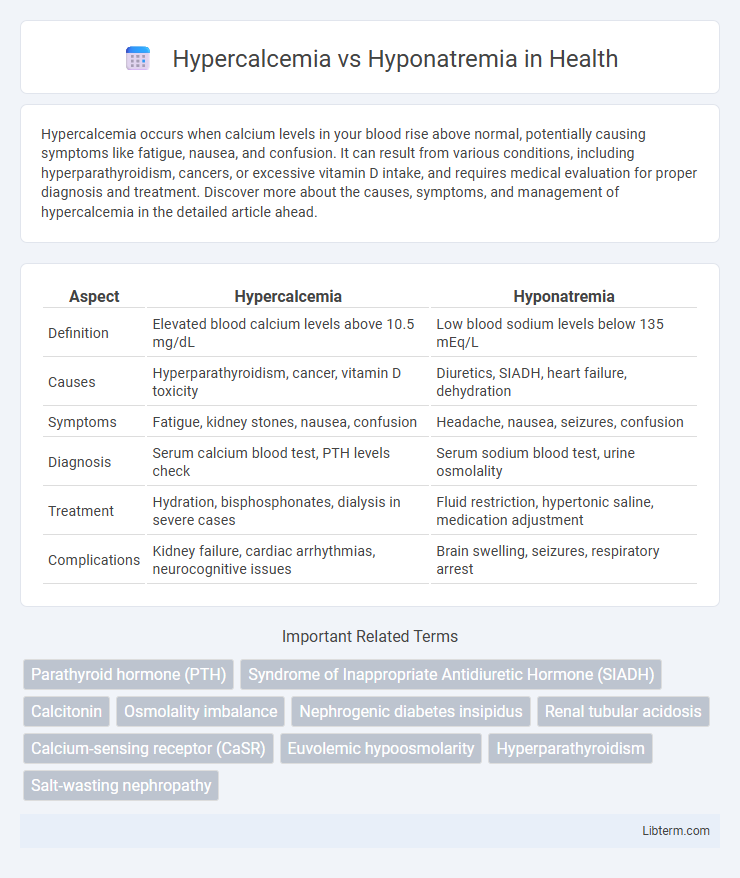Hypercalcemia occurs when calcium levels in your blood rise above normal, potentially causing symptoms like fatigue, nausea, and confusion. It can result from various conditions, including hyperparathyroidism, cancers, or excessive vitamin D intake, and requires medical evaluation for proper diagnosis and treatment. Discover more about the causes, symptoms, and management of hypercalcemia in the detailed article ahead.
Table of Comparison
| Aspect | Hypercalcemia | Hyponatremia |
|---|---|---|
| Definition | Elevated blood calcium levels above 10.5 mg/dL | Low blood sodium levels below 135 mEq/L |
| Causes | Hyperparathyroidism, cancer, vitamin D toxicity | Diuretics, SIADH, heart failure, dehydration |
| Symptoms | Fatigue, kidney stones, nausea, confusion | Headache, nausea, seizures, confusion |
| Diagnosis | Serum calcium blood test, PTH levels check | Serum sodium blood test, urine osmolality |
| Treatment | Hydration, bisphosphonates, dialysis in severe cases | Fluid restriction, hypertonic saline, medication adjustment |
| Complications | Kidney failure, cardiac arrhythmias, neurocognitive issues | Brain swelling, seizures, respiratory arrest |
Introduction to Hypercalcemia and Hyponatremia
Hypercalcemia is characterized by elevated calcium levels in the blood, often exceeding 10.5 mg/dL, and can result from hyperparathyroidism, malignancies, or excessive vitamin D intake. Hyponatremia involves a low sodium concentration below 135 mmol/L, frequently caused by conditions such as heart failure, liver disease, or the syndrome of inappropriate antidiuretic hormone secretion (SIADH). Both electrolyte imbalances disrupt normal cellular functions and require accurate diagnosis to determine the underlying etiology and appropriate treatment.
Definition and Pathophysiology
Hypercalcemia is characterized by elevated serum calcium levels above 10.5 mg/dL, often stemming from hyperparathyroidism or malignancies, leading to increased bone resorption and renal calcium reabsorption. Hyponatremia involves low serum sodium concentration below 135 mEq/L, commonly caused by excessive water retention or sodium loss, resulting in cellular swelling due to osmotic imbalance. Both conditions disrupt electrolyte homeostasis, affecting neuromuscular and cardiovascular function through distinct mechanisms of ion regulation.
Causes of Hypercalcemia
Hypercalcemia is primarily caused by hyperparathyroidism, malignancies such as multiple myeloma and metastatic cancers, and excessive vitamin D or calcium intake. Other causes include granulomatous diseases like sarcoidosis, certain medications like thiazide diuretics, and prolonged immobilization. Unlike hyponatremia, which results from imbalances in sodium and water, hypercalcemia reflects elevated calcium disrupting normal cellular functions.
Causes of Hyponatremia
Hyponatremia, characterized by low sodium levels in the blood, commonly results from conditions such as heart failure, liver cirrhosis, kidney disease, and the syndrome of inappropriate antidiuretic hormone secretion (SIADH). Excessive fluid intake or administration of hypotonic intravenous fluids can dilute sodium concentration, leading to hyponatremia. Medications like diuretics, antidepressants, and antiepileptics also contribute to impaired sodium balance, differentiating it from hypercalcemia, which involves elevated calcium levels primarily caused by hyperparathyroidism or malignancies.
Clinical Manifestations: Comparing Symptoms
Hypercalcemia commonly presents with symptoms such as muscle weakness, fatigue, polyuria, and confusion, while hyponatremia often manifests as headache, nausea, vomiting, seizures, and altered mental status. Hypercalcemia's clinical signs include constipation and kidney stones, contrasting with the cerebral edema and neurological deficits seen in severe hyponatremia. Differentiating these conditions relies on the distinct symptom profiles linked to calcium and sodium imbalances.
Diagnostic Approaches
Diagnostic approaches for hypercalcemia primarily involve measuring serum calcium levels, ionized calcium, and parathyroid hormone (PTH) assays to differentiate between PTH-dependent and PTH-independent causes. In hyponatremia, the diagnostic evaluation includes assessing serum sodium concentration, plasma osmolality, urine osmolality, and urine sodium levels to identify the underlying etiology such as hypovolemic, euvolemic, or hypervolemic states. Advanced imaging and endocrine tests may be employed to further investigate underlying conditions contributing to abnormal electrolyte imbalances.
Laboratory Evaluation and Findings
Hypercalcemia typically presents with elevated serum calcium levels above 10.5 mg/dL, often accompanied by suppressed parathyroid hormone (PTH) in malignancy-related cases or elevated PTH in primary hyperparathyroidism; serum phosphate is usually low or normal. Hyponatremia is characterized by serum sodium levels below 135 mEq/L, requiring assessment of serum osmolality and urine sodium to differentiate causes such as hypovolemic, euvolemic, or hypervolemic states. Laboratory evaluation of hypercalcemia often includes PTH, vitamin D metabolites, and renal function tests, while hyponatremia workup involves assessing volume status, urine osmolality, and endocrine function like cortisol and thyroid hormones.
Treatment Strategies for Hypercalcemia
Treatment strategies for hypercalcemia primarily involve intravenous hydration with isotonic saline to enhance renal calcium excretion, followed by the use of bisphosphonates such as zoledronic acid or pamidronate to inhibit bone resorption. In severe cases, corticosteroids may be administered to reduce intestinal calcium absorption, while loop diuretics like furosemide can be employed cautiously after rehydration to promote calcium excretion. Dialysis is considered in refractory hypercalcemia or patients with renal failure, ensuring aggressive management to prevent complications like cardiac arrhythmias and neurotoxicity.
Management Options for Hyponatremia
Management options for hyponatremia primarily depend on its severity and underlying cause, with mild cases often treated by fluid restriction to prevent further dilution of sodium levels. In more severe or symptomatic hyponatremia, hypertonic saline (3% NaCl) is administered cautiously to raise serum sodium while avoiding rapid correction that may cause osmotic demyelination syndrome. Additional therapies include addressing underlying conditions such as heart failure or SIADH, using vasopressin receptor antagonists (vaptans), and monitoring electrolyte levels closely during treatment to ensure safe sodium normalization.
Prognosis and Complications
Hypercalcemia often leads to complications such as kidney stones, cardiac arrhythmias, and neuropsychiatric disturbances, with prognosis depending on the underlying cause and promptness of treatment. Hyponatremia can result in cerebral edema, seizures, and increased mortality risk, especially in severe or chronic cases, with prognosis improving significantly with early correction of sodium imbalance. Both electrolyte imbalances require urgent medical evaluation to prevent long-term organ damage and improve patient outcomes.
Hypercalcemia Infographic

 libterm.com
libterm.com